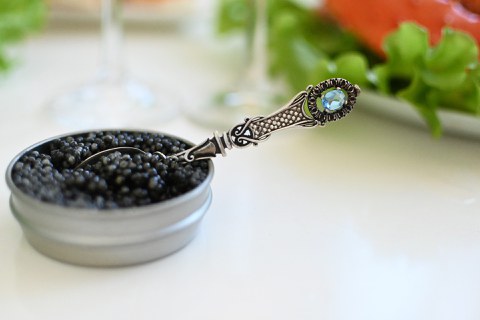Jul 16, 2024
Animals and Money: Edible Gold – How Valuable is the Global Caviar Market?

Caviar plays an important role in the market of luxury food, not only a food item but also as a symbol of wealth. The time-consuming process of caviar production, along with overexploitation of caviar-producing sturgeon species have led to caviar being the most valuable fish roe product worldwide.
Saffron, truffles, caviar: Luxury food items create a very profitable market. Globally, the market for luxury food was valued at 268 billion US$ in 2020. The largest share is taken up by luxury seafood, like oysters and caviar, and accounts for 30% of the luxury food market, or an estimated 80.4 billion US$ [1]. Known colloquially as “edible gold” [2], caviar is not only a food item but also a symbol of wealth.
Caviar refers to salt-cured, unfertilized eggs (roe) of sturgeons [3]. In 2018, 380 t of caviar were produced globally [4]. Modern caviar production almost completely relies on sturgeons farmed in aquacultures [5], the most common of which are Siberian sturgeon, Russian sturgeon and White sturgeon [4, 6, 7, 8]. A less commonly farmed, but certainly more expensive variety, is caviar from Beluga sturgeon [4, 7]. Female sturgeons can produce an amount of eggs equivalent to 10-30% of their body weight every time they lay eggs [8]. With each spawning, individual females of Beluga sturgeon produce between 15 - 20 kg caviar, Russian females between 5 - 20 kg caviar and Siberian females between 5 - 8 kg caviar [8]. Beluga caviar can be worth between 5,000 - 10,000 US$/kg [9], caviar from Russian sturgeon between 1,500 - 4,000 US$/kg [10, 11] and caviar from Siberian sturgeon between 950 - 3,000 US$/kg [12]. Depending on which of these sturgeon species, the caviar produced by a single female can therefore be worth around 4,750 – 200,000 US$ in retail. Since the sturgeons are usually killed for egg harvesting once they first spawn, this value would not increase through further spawning [4]. Using the value of caviar of the sturgeon species above, the amount of caviar produced worldwide in 2018 could have been worth 361 million – 3.8 billion US$! Excluding the more expensive and less commonly farmed Beluga sturgeon from the calculation, the turn-over could be estimated at a more realistic 361 million – 1.52 billion US$. Although the price estimates for caviar are rather broad, caviar business seems to be very profitable. The broad range of caviar prices is influenced by the use of different sturgeon species and other factors, like the farming country and how long the fish are reared until they can lay eggs [4, 13, 14].
The time-consuming process of caviar production, along with overexploitation and ensuing near extinction of caviar-producing sturgeon species have also led to caviar being the most valuable fish roe product worldwide [4, 6, 15]. To combat legal and illegal overfishing and habitat destruction, the trade of both sturgeon and its roe has been regulated under CITES (the Convention on International Trade in Endangered Species) since 1998 [4, 6]. Despite the existing species protection regulations, there is a big and lucrative illegal caviar market, estimated to exceed the legal market between four and ten times [2, 7].
As shown, caviar plays an important role in the market of luxury (sea)food. The production of caviar in aquaculture will likely allow the caviar market to expand, as the product will be cheaper than wild caviar and therefore more accessible to the middle-class [13]. At the same time, traditionally sourced wild caviar will continue to be in demand, as an identifier of wealth [13]. Either way, caviar production will likely continue to be important. Given that species protection violations and overexploitation have so far been linked to the caviar business, the protection of sturgeons should be guaranteed, and if necessary stronger regulations should be put into place, as the demand for caviar increases.
Lilli Kratzer
Issue 25 (PDF)
